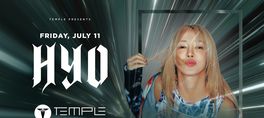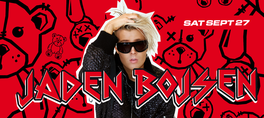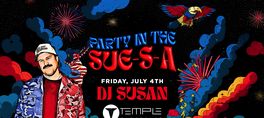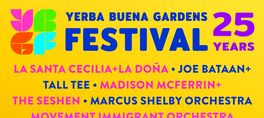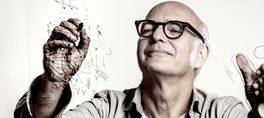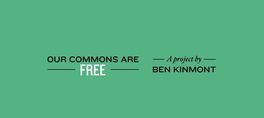Opening reception Sat, Oct 19, 4-6pm; Exhibition Saturday, October 19 - Wednesday, November 27; Tues, Wed, Fri, Sat from 10 am - 5:30 pm & Thurs from 11 am - 7 pm
Dusseldorf-based Jutta Haeckel may be the most original painter of her generation. Her recent paintings on jute-the strong, coarse, natural fiber that burlap is made of-utilize a series of unorthodox techniques to undermine the physical and conceptual precepts of painting.
For several years, Haeckel has been developing a technique that inverts traditional processes of depiction. Rather than painting a form, she paints the negative space around the form, confounding one's perception of foreground and background as well as the meaning of "subject." In her newest work, in addition to her already eccentric process, she applies pigments to the "backside" of the painting, then pushes paint through small gaps in the fabric-extruding it onto the "front"-further subverting the two-dimensional space of traditional painting.
Technically dichotomous-painted from both sides; seemingly gestural, yet quite controlled; at the same time abstract and representational; micro and macro-Haeckel's paintings are studies in ambiguity. Their Double Nature, she believes, is a reflection of the technological, scientific, social and cultural fluidity of our time.
As a counterpoint to Haeckel's paintings, Hosfelt Gallery will exhibit a group of antique stone objects from the temple gardens of Kyoto. While Haeckel's paintings can be said to be about flux, the basins, pagodas, lanterns and foundation stones-some dating as early as the Kamakura Period (1185-1300)-exude serenity and solidity. These stone objects are shown in association with Mitsui Fine Arts.
Free
Presented by Hosfelt Gallery, San Francisco.
show less
Dusseldorf-based Jutta Haeckel may be the most original painter of her generation. Her recent paintings on jute-the strong, coarse, natural fiber that burlap is made of-utilize a series of unorthodox techniques to undermine the physical and conceptual precepts of painting.
For several years, Haeckel has been developing a technique that inverts traditional processes of depiction. Rather than painting a form, she paints the negative space around the form, confounding one's perception of foreground and background as well as the meaning of "subject." In her newest work, in addition to her already eccentric process, she applies pigments to the "backside" of the painting, then pushes paint through small gaps in the fabric-extruding it onto the "front"-further subverting the two-dimensional space of traditional painting.
Technically dichotomous-painted from both sides; seemingly gestural, yet quite controlled; at the same time abstract and representational; micro and macro-Haeckel's paintings are studies in ambiguity. Their Double Nature, she believes, is a reflection of the technological, scientific, social and cultural fluidity of our time.
As a counterpoint to Haeckel's paintings, Hosfelt Gallery will exhibit a group of antique stone objects from the temple gardens of Kyoto. While Haeckel's paintings can be said to be about flux, the basins, pagodas, lanterns and foundation stones-some dating as early as the Kamakura Period (1185-1300)-exude serenity and solidity. These stone objects are shown in association with Mitsui Fine Arts.
Free
Presented by Hosfelt Gallery, San Francisco.
Opening reception Sat, Oct 19, 4-6pm; Exhibition Saturday, October 19 - Wednesday, November 27; Tues, Wed, Fri, Sat from 10 am - 5:30 pm & Thurs from 11 am - 7 pm
Dusseldorf-based Jutta Haeckel may be the most original painter of her generation. Her recent paintings on jute-the strong, coarse, natural fiber that burlap is made of-utilize a series of unorthodox techniques to undermine the physical and conceptual precepts of painting.
For several years, Haeckel has been developing a technique that inverts traditional processes of depiction. Rather than painting a form, she paints the negative space around the form, confounding one's perception of foreground and background as well as the meaning of "subject." In her newest work, in addition to her already eccentric process, she applies pigments to the "backside" of the painting, then pushes paint through small gaps in the fabric-extruding it onto the "front"-further subverting the two-dimensional space of traditional painting.
Technically dichotomous-painted from both sides; seemingly gestural, yet quite controlled; at the same time abstract and representational; micro and macro-Haeckel's paintings are studies in ambiguity. Their Double Nature, she believes, is a reflection of the technological, scientific, social and cultural fluidity of our time.
As a counterpoint to Haeckel's paintings, Hosfelt Gallery will exhibit a group of antique stone objects from the temple gardens of Kyoto. While Haeckel's paintings can be said to be about flux, the basins, pagodas, lanterns and foundation stones-some dating as early as the Kamakura Period (1185-1300)-exude serenity and solidity. These stone objects are shown in association with Mitsui Fine Arts.
Free
Presented by Hosfelt Gallery, San Francisco.
read more
Dusseldorf-based Jutta Haeckel may be the most original painter of her generation. Her recent paintings on jute-the strong, coarse, natural fiber that burlap is made of-utilize a series of unorthodox techniques to undermine the physical and conceptual precepts of painting.
For several years, Haeckel has been developing a technique that inverts traditional processes of depiction. Rather than painting a form, she paints the negative space around the form, confounding one's perception of foreground and background as well as the meaning of "subject." In her newest work, in addition to her already eccentric process, she applies pigments to the "backside" of the painting, then pushes paint through small gaps in the fabric-extruding it onto the "front"-further subverting the two-dimensional space of traditional painting.
Technically dichotomous-painted from both sides; seemingly gestural, yet quite controlled; at the same time abstract and representational; micro and macro-Haeckel's paintings are studies in ambiguity. Their Double Nature, she believes, is a reflection of the technological, scientific, social and cultural fluidity of our time.
As a counterpoint to Haeckel's paintings, Hosfelt Gallery will exhibit a group of antique stone objects from the temple gardens of Kyoto. While Haeckel's paintings can be said to be about flux, the basins, pagodas, lanterns and foundation stones-some dating as early as the Kamakura Period (1185-1300)-exude serenity and solidity. These stone objects are shown in association with Mitsui Fine Arts.
Free
Presented by Hosfelt Gallery, San Francisco.
show less
Date/Times:
260 Utah Street, San Francisco, CA 94103
The Best Events
Every Week in Your Inbox
From Our Sponsors
UPCOMING EVENTS
Great suggestion! We'll be in touch.
Event reviewed successfully.
